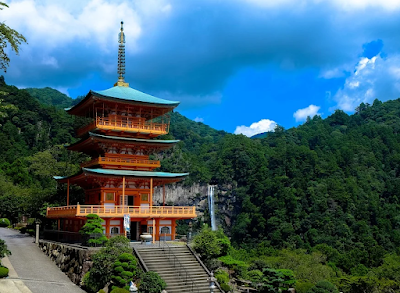Pagodas in Japan are called tō (塔, lit. pagoda), sometimes buttō (仏塔, lit. Buddhist pagoda) or tōba (塔婆, lit. pagoda). They certainly historically derive from the Chinese pagoda (itself an interpretation of the Indian stupa). Much like the stupa, pagodas were originally used as reliquaries but in many cases they ended up losing this function, indeed. Pagodas are quintessentially Buddhist and an important component of Japanese Buddhist temple compounds but, because until the Kami and Buddhas Separation Act of 1868, a Shinto shrine was normally also a Buddhist temple and vice versa, they are not really rare at shrines either. The famous Itsukushima Shrine, for example, certainly has one.
A "reliquary" is a container for holy relics.
After the so-called Meiji Restoration the word tō, once used exclusively in a religious context, came to mean also "tower" in the western sense, as for example in Eiffel tower (エッフェル塔, Efferu-tō).
Of the Japanese pagoda's many various forms, some are built in wood and are collectively known as mokutō (木塔, lit. wood pagoda), but most are carved out of stone (sekitō (石塔, lit. stone pagoda). Wood pagodas are really large buildings with either 2 stories (like the tahōtō (多宝塔, lit. Tahō pagoda), see photo below) or an odd number of stories. Extant wood pagodas with more than 2 storeys have almost always either 3 stories (and are therefore called sanjū-no-tō (三重塔, lit. three-storeyed pagoda)) or five (and are called gojū-no-tō (五重塔, lit. five-storeyed pagoda). Stone pagodas are nearly always small, usually well below 3 metres, and as a rule offer no usable space. If they have more than one storey, pagodas are called tasōtō (多層塔, lit. multi-storied pagoda) or tajūtō (多重塔, lit. multi-storied pagoda).
A pagoda's size is measured in ken, where a ken is the interval between two pillars of a traditional-style building. A tahōtō for example can be either 5x5 ken or 3x3 ken. The interesting word is usually translated in English as "bay" and is better understood as an indication of proportions than as a unit of measurement.
The ken so-called (間) is a traditional Japanese unit of length, equal to 6 Japanese feet (shaku). The exact value has varied over time and location but has generally been a little shorter than 2 meters (6 ft 7 in). It now seems to be standardized as 1.82 m.
パゴダ Pagoda
仏教徒 Buddhist
聖骨箱 Reliquary
遺物 Relic
寺 Temple
神社 Shrine
タワー Tower
木 Wood
結石 Stone
計測 Measurement

No comments:
Post a Comment